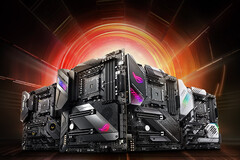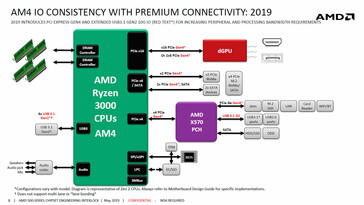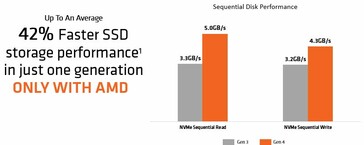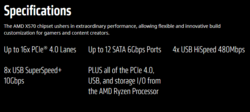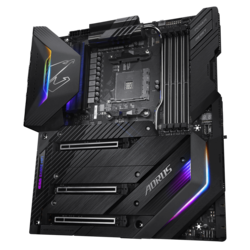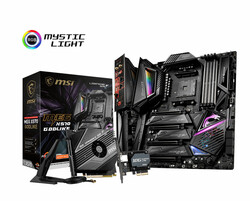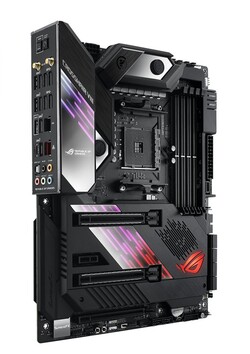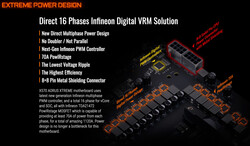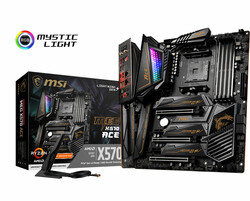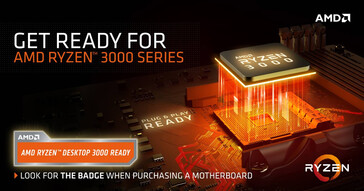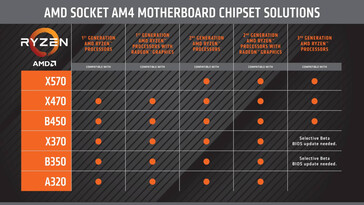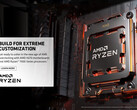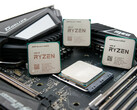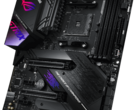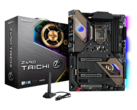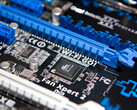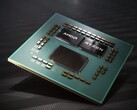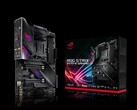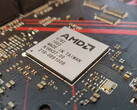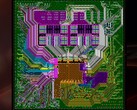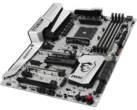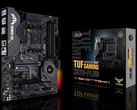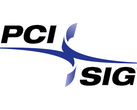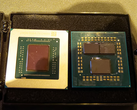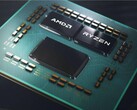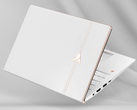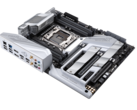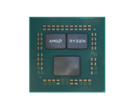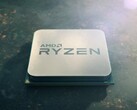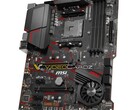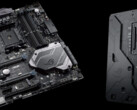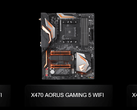While we've been seeing some great hardware launches at Computex 2019, AMD's announcement of the new Ryzen 3000 CPUs clearly stole the show. Alongside the processors, the launch of AMD's new flagship X570 chipset was also a talking point. AMD CEO Dr. Lisa Su did not delve deep into the specifics of the chipset on stage but we are now getting to learn some specifics during the course of the event. So here is a round-up of all the X570 news so far.
Connectivity
The X570 chipset is AMD's flagship offering for motherboard vendors this year and is a completely PCIe Gen4 platform. The Ryzen 3000 processors already house necessary controllers such as PCIe x16, SATA, USB 3, audio, SPI, etc. on die so the X570 is relatively free to offer the maximum bandwidth for peripheral connections such as additional USB 3.1 Gen2, Wi-Fi 6, 10 Gb LAN, and SATA. As a result, we find OEMs endowing their high-end offerings with considerably high numbers of USB Gen2 ports and headers. The X570 chipset communicates to the CPU via a PCIe Gen4 x4 connection.
Several OEMs have started issuing BIOS updates for PCIe Gen4 support on the PCIe x16 slot closest to the CPU for X470 and B450 motherboards as well. This means if you pair a new Ryzen 3000 processor with the above last-gen chipsets after a corresponding BIOS update, you should be able to get PCIe Gen4 support from the CPU at least. The new X570 chipsets come with 40 native PCIe Gen4 lanes (CPU + chipset) that promise 2x the bandwidth of PCIe Gen3 (up to 32 GB/s per x16 slot). There are currently no consumer GPUs that can harness this potential, but future-proofing is always a good thing.
Storage is a key benefactor of the move to Gen4. Phison has already announced the first Gen4 NVMe 1.3 controllers and we are seeing many PCIe Gen4 NVMe SSDs at Computex 2019 already hitting 5 GB/s read speeds.
In case you were wondering, there is no Thunderbolt 3 support on X570 likely due to higher costs and supposed difficulty in certification process with Intel that requires sharing CPU microcode.
Also, unlike before, AMD is developing the new chipsets in-house by licensing appropriate technology instead of outsourcing them to ASMedia as was the case with the X370 and the X470.
Power consumption — Equivalent to a 15W ULV CPU
During the initial leaks, we saw that the most of the pictures showed a fan on top of the chipset heatsink leading to speculation that this chipset is a power guzzler. Turns out that it is indeed true. The X570 chipset for consumer motherboards requires 11W of power (for perspective, the X470 consumed just 6W) while the enterprise version requires as much as 15W (for even higher lane counts). This is likely because of the high-bandwidth PCIe Gen4 lanes that the X570 platform supports.
This has raised some concerns about additional heat and fan noise that would likely emanate from these boards. But OEMs are wary of this and have incorporated suitable measures for silent operation. Hardware Canucks reports that MSI is using technology from their Twin Frozr GPUs to stop the chipset fan during idle along with using propeller blades for better airflow. AMD is also reportedly planning to incorporate additional power management features before availability in July 7.
Gigabyte is probably the only OEM not using an active fan for cooling the X570 chipset in the flagship X570 Aorus Extreme, but it does use a continuous heatpipe that runs from the VRMs all the way till the chipset.
CPU overclocking — Better, but not overly different from X470 on air
MSI feels that the best CPU overclocks for Ryzen 3000 are achieved on liquid cooling and users might not find much of an improvement on air when compared to the X470. Optimum Tech reports that the lower-end MSI Gaming Plus and Edge models have IR35201 PWM controllers for VRMs that are arranged in an 8+2+1 phase configuration. Therefore, most X570 motherboards will be able to handle even the Ryzen 9 3900X 12C/24T CPU without much of an issue and these boards also come with 8+4 or 8+8 pins for CPU power supply.
The top-end MSI MEG ACE uses a 12-phase VRM for the CPU (likely doubled 6-phase) while the flagship MSI X570 Godlike and Creation boards use a 14+2 phase VRM for the CPU and SoC. These three boards also sport a continuous heatpipe running from the VRMs till the chipset emphasizing that the new platform does require adequate cooling for pushing the clocks.
Asus has also improved its VRM implementation to cater to the new high-core count Ryzens and the flagships ROG Crosshairs use 16-phase VRMs with large heatsinks. For smaller boards such as the new mini-DTX Crosshair VIII Impact, the VRMs feature a cooling fan to compensate for the smaller heatsinks. The flagship Asus X570 Crosshair VIII Formula sports a CrossChill EK III water block for liquid-cooling the 16-phase 60A VRMs and is also designed to be used with custom liquid loops.
While we aren't quite sure whether Asus is implementing a phase doubler or not, Gigabyte has confirmed that it is using a direct 16-phase 70A power design for the X570 Aorus Extreme and a direct 14-phase VRM solution for the X570 Aorus Master.
Thus, we see that OEMs have had to improve on power delivery for stable overclocking on top-tier Ryzen 3000 chips. We expect to see some impressive numbers in benchmarks when the new CPUs are pushed to their limits on liquid cooling or even liquid nitrogen.
Server-grade components and improved memory overclocking
Hardware Canucks spoke to MSI who said that the enhanced signalling required them to use server-grade reinforced PCIe traces between the CPU, chipset, and the PCIe slots across their entire lineup to prevent signal loss. Ryzen is heavily dependent of memory performance and overclockers will be glad to know that memory overclocking has been significantly improved in this generation.
According to MSI, it is perfectly possible to run 4400 MHz DDR4 RAM kits on air even on their lower-end X570 offerings, which indeed augurs well for enthusiasts. The higher-end MSI boards offer tighter DRAM timings and use improved VRMs to achieve 4600 MHz on air and up to 5 GHz on liquid nitrogen. Of course, we will have to wait for review samples to put these claims to test.
Backward compatibility — Bad news for 1st gen Summit Ridge and Raven Ridge users
Ever since we've been hearing news about OEMs dropping support for AMD Bristol Ridge and questionable support for Ryzen 3rd generation on the budget A320 chipset, backward compatibility has become a talking point. AMD has finally opened up on CPU support for various chipsets and it looks like the X570 chipset wont be compatible with 1st generation Summit Ridge and Raven Ridge processors. This is antithetical to what AMD promised during the launch of Ryzen 1st gen, but apparently there have been difficulties in accommodating all the microcode for every Ryzen processor out there.
Speaking to Tom's Hardware, Robber Hallock, AMD's Senior Technical Marketing Manager said,
If we look across the ecosystem of motherboards that exist today, we certainly make BIOS updates available to our ecosystem partners to include that on different levels of motherboards in their portfolio, but I don't expect that every motherboard will be updated for 3000 Series processors from our partners. That really will be a portfolio decision from their standpoint as well, as to where they apply those updates, and where they choose not to apply those updates."
Right now, there should not be any issues in dropping a Ryzen 3000-series CPU on an X470 or B450 motherboard. Supporting the new CPUS on older X370 and B350 boards is being left to the OEM's discretion while A320 boards are totally ruled out.
To be fair to AMD, the kind of socket support we are seeing is still a big deal considering Intel requires a socket upgrade with almost every new generation. Also, the Summit Ridge SKUs have reached EOL last year with the announcement of Pinnacle Ridge so it doesn't really make business sense to add backward compatibility for these processors on X570. We are not sure if AMD would announce an upgraded budget chipset some time later this year.


 Deutsch
Deutsch English
English Español
Español Français
Français Italiano
Italiano Nederlands
Nederlands Polski
Polski Português
Português Русский
Русский Türkçe
Türkçe Svenska
Svenska Chinese
Chinese Magyar
Magyar